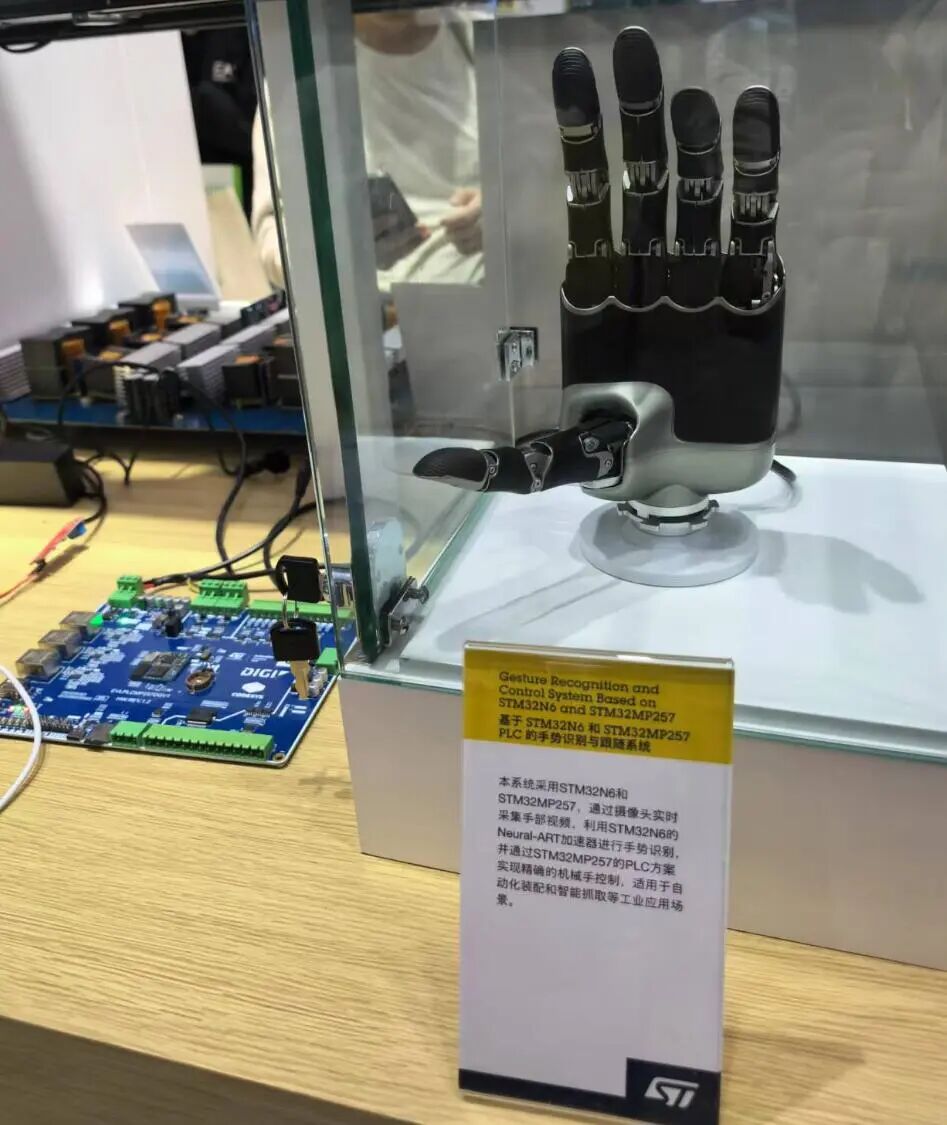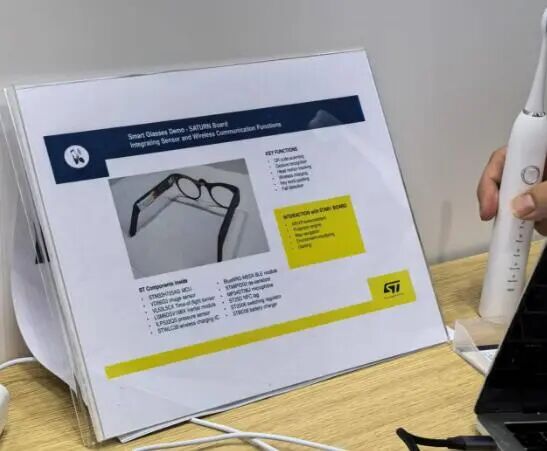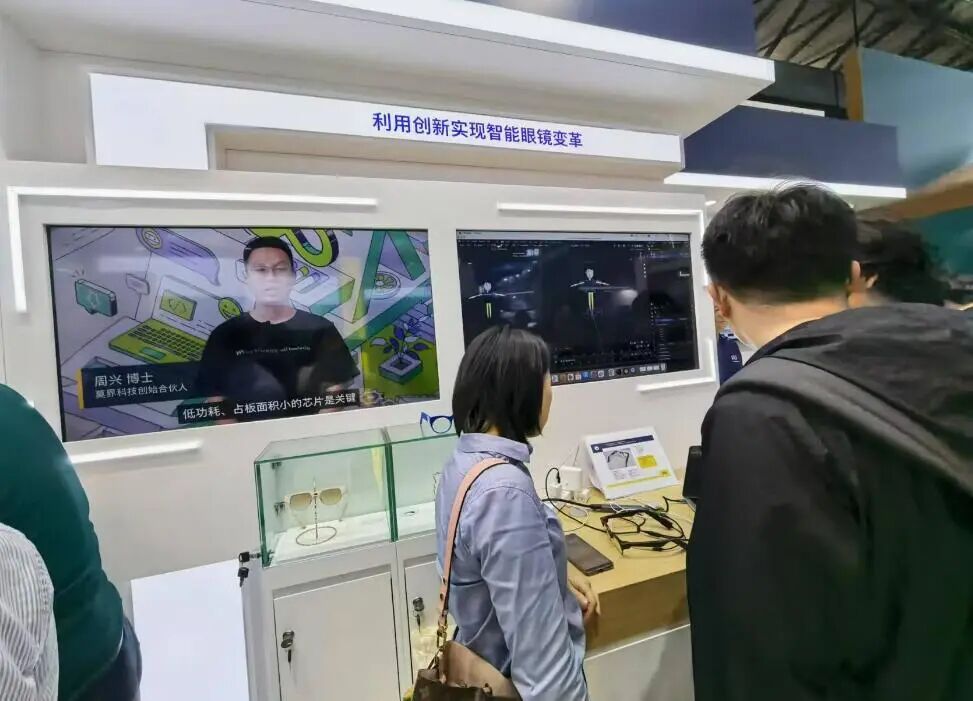According to a report from Electronic Enthusiasts (by Zhang Ying), the Munich Shanghai Electronics Show grandly opened on April 15. From AI glasses in the consumer sector to vital sign monitoring in smart healthcare, and to the perception joints of robotic dexterous hands, the trend of edge AI MCUs facilitating terminal deployment is becoming increasingly evident. Edge artificial intelligence is gaining more attention from ODM manufacturers and terminal hardware manufacturers due to its advantages of protecting privacy without uploading data to the cloud, saving power, achieving low-latency responses, and lightweight chips.
At the STMicroelectronics booth, the reporter saw exhibits such as a gesture recognition and tracking system based on the STM32N6 and STM32MP257 PLC. Additionally, the MoJie AR glasses, weighing only 35 grams, made a grand debut, achieving 10 hours of battery life, with the high-performance microcontroller STM32N6 chip playing a crucial role. Therefore, the reporter specially interviewed Ding Xiaolei, the marketing manager of STMicroelectronics’ Microcontroller, Digital IC, and RF Products Division in China, to share insights about the performance and architectural advantages of the STM32N6 chip, as well as its ecosystem and algorithms in AI glasses and other edge terminal applications, and how the platform helps customers bring products to market quickly.
STM32N6: Enabling Gesture Recognition and Industrial Automation Applications
The gesture recognition and tracking system based on STM32N6 and STM32MP257 PLC utilizes the STM32N6 and STM32MP257 to capture hand video in real-time through a camera and employs the Neural-ART accelerator of STM32N6 for gesture recognition. “This exhibit can accurately identify 21 points on the hand, running two algorithms: one for palm recognition and the other for tracking the 21 precise points on the hand, including front, side, and inverted views. Through an extended gateway, it can also control dexterous hands, thus mimicking human gestures,” Ding Xiaolei stated. “This solution is not only suitable for industrial applications such as automation equipment and intelligent grasping but can also be extended to home appliance control.”

Figure: Dexterous Hand Demo Display, captured by Electronic Enthusiasts
“The STM32N6 is STMicroelectronics’ first STM32 MCU embedded with the self-developed neural processing unit (NPU) — ST Neural-ART accelerator™, designed specifically for energy-efficient edge AI applications. This product has a clock frequency of up to 1 GHz and a computing performance of 600 GOPS, providing real-time neural network inference capabilities for computer vision and audio applications,” Ding Xiaolei introduced. “The N6 chip is expected to be mass-produced and released in December 2024, with customers using the N6 chip for new product development and educational purposes. Some partners plan to showcase the latest development applications based on the N6 chip in June this year, focusing on consumer, home appliance, medical, and robotics applications.”
Exploding Demand for AI Glasses, Unique Architectural Advantages of STM32 N6 Drive Application Deployment
AI glasses are a subcategory of smart glasses equipped with AI functions, capable of deploying AI large models locally or calling them from the cloud. Their market share in the smart glasses sector is expected to rise from 26.1% in 2024 to 38.7% in January-February 2025, with an anticipated annual share exceeding 60% in 2025.

Figure: MoJie AR Glasses Display, captured by Electronic Enthusiasts
The MoJie AR glasses showcased by ST, weighing only 35 grams, are the lightest dual-lens AR glasses globally, achieving 10 hours of battery life. How does this glasses achieve a balance between low power consumption and high performance? Ding Xiaolei revealed the secret on-site. She explained that the MoJie AI glasses are centered around the STM32 N6, as the STM32N6 matches the lightweight AR glasses’ characteristics and supports advanced perception and interactive functions; these functions require low power consumption, minimal computational load, and nearly zero latency, such as SLAM, gesture control, and eye-tracking functions, and are integrated with generative artificial intelligence, leading to many innovative applications.

Figure: On-site Explanation of AR Glasses, captured by Electronic Enthusiasts
Moreover, Ding Xiaolei pointed out that due to the outstanding low power performance of the STM32N6 chip, the product adopts an MCU architecture. Compared to SoC architecture, the MCU+NPU architecture allows the chip itself to achieve low power consumption. The chip supports two power supply modes of 1.8V and 3.3V, with wearable products preferring 1.8V power supply for power savings. The scenarios with higher power consumption in AI glasses mainly involve photography, where data is scaled after passing through the ISP before AI processing. Therefore, the integrated link design of the STM32N6 chip ensures that power consumption reaches the minimum value in pipeline design. Unlike other terminals, it does not require a large SoC and does not run redundant operating systems.
In addition to AI glasses, customers developing AI toys and AI companion robots are also collaborating with ST. The demand for AI toys focuses on miniaturization, low power consumption, and the ability to perform facial and emotional recognition, providing a good human-machine interaction experience. These functions require edge-side and lightweight AI chips to achieve. ST’s edge AI MCU chip can support 0.6 TOPS, and the STM32N6 chip’s MCU can achieve a startup time of 2-3 milliseconds, far exceeding the efficiency of SoC startups, making it easier to realize for terminals and application scenarios with real-time requirements.
“To help engineers accelerate the deployment of large models to products, ST has launched a software tool suite called ST Edge AI Suite, aimed at simplifying the development and deployment of embedded AI applications. The entire software suite supports the optimization and deployment of machine learning algorithms, from initial data collection to final model deployment on hardware, simplifying the entire AI development process,” Ding Xiaolei analyzed. “This environment allows developers to easily select models and data sources, quickly find suitable tools to optimize models, conduct benchmark tests, and automatically generate code and machine learning libraries. Most tasks can be completed within a unified framework, greatly simplifying the development work. Developers can place the trained models on ST’s AI tool platform, and within minutes, calculate the required FLASH DRAM and model inference time for the model running on the MCU. Through this process, customers can quickly evaluate and shorten the product development cycle.”
Three Major Edge Terminal Products Show Promising Growth Prospects, ST Initiates Next-Generation Chip Design
Which edge AI terminals will become new growth points in 2025? Ding Xiaolei stated that three categories of products have already become potential growth points. First, consumer terminals such as AI glasses, including AI headphones, smart wristbands, and AI PIN products, all have good market growth opportunities; second, smart home appliances, with strong demand for appliance intelligence, have extreme requirements for chip size and cost. How to utilize the minimum cost to realize intelligence in home appliances will be a key focus of the future market. At the 2025 AWE exhibition, AI Eye can recognize home appliances through vision, achieving real-time control through AI predictive maintenance and time series algorithms, leading to a more efficient customer experience; third, robotics, which, although not yet in large quantities, includes humanoid robots, companion robots, and other sub-sectors requiring edge AI intervention, with many companies accelerating entry and new product development, which will be a new growth point in the future.
In Ding Xiaolei’s view, for embedded terminal products, it is not about having the most powerful functions, but rather considering the chip’s area and cost. The key demand from customers is to achieve an optimal cost-performance and energy efficiency ratio for the chip.
“The STM32N6 chip adopts TSMC’s 16nm process, and ST mainly focuses on empowering the chip’s functionality, main frequency, and algorithms. In the planning of the next generation of products, ST will listen to more voices from the Chinese market. In the second half of this year and next year, our next-generation products will adopt heterogeneous architecture, where the integrated co-processor processes content without occupying resources between the MCU, maximizing efficiency,” Ding Xiaolei concluded. “As more developers adopt the STM32N6 chip for development board design and terminal design, the expected shipment volume of this chip will significantly increase next year.”

Disclaimer: This article is originally from Electronic Enthusiasts, please indicate the source above when reprinting. For group discussions, please add WeChat elecfans999,for submission and interview requests, please email [email protected].
More Hot Articles to Read
-
AI Toys: Competing with multiple solutions focusing on multi-turn dialogue and emotional companionship
-
On-site Coverage: Marathon Star “Tian Gong Robot”, Zhaowei Electromechanical Dexterous Hand, etc. are highly sought after
-
Cadence Acquires Arm’s Basic IP Business, Who is the Winner?
-
Humanoid Robots Steal the Show at Auto Shows, Commercialization Inflection Point Accelerates
-
Direct Coverage of the 2025 Shanghai Auto Show, Supply Chain Giants Collectively “Debut”, Chinese Technology Rewrites Global Rules
Click to Follow and Star Us